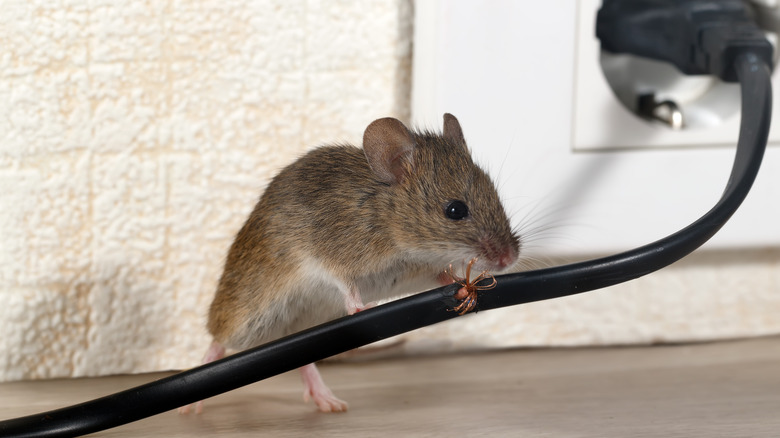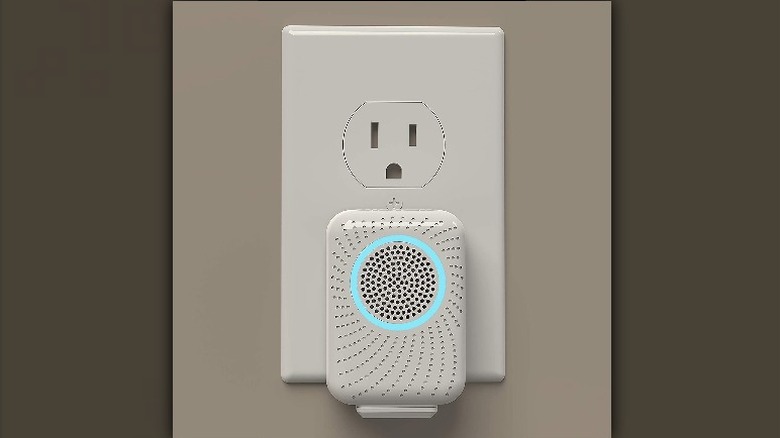Do Plug-In Pest Repellents Really Keep Mice Out Of Your Home?
We may receive a commission on purchases made from links.
Nobody wants to see mice scurrying around their home, leaving droppings and potentially spreading diseases. For this reason, many homeowners will stop at nothing to remove them — even resorting to electric ultrasonic devices as part of the purging plan. Unfortunately, when it comes to ridding a home of mice, plug-in pest repellents rarely deliver the desired results.
Plug-in pest repellents emit continuous high-frequency sounds designed to irritate and dissuade insects and rodents from entering your home. Once the device is inserted into an outlet it releases electronic frequencies between 20,000 hertz and 65,000 hertz depending on make and model. In theory, the ultrasonic noise triggers a seizure response in mice and eventually drives them out of your house. According to the National Institutes of Health, humans only detect sounds ranging from about 20 hertz to 20,000 hertz. Consequently, the noise generated by plug-in repellents is inaudible and safe for homeowners and families.
Why they don't work
Advertising strategies for plug-in pest repellents tout their convenience, chemical-free composition, and safety to humans. But, it begs the question: Are plug-in pest repellents too good to be true? The simple answer is yes. In fact, in 2001, the Federal Trade Commission (FTC) formally warned more than 60 plug-in pest-repellent manufacturers and retailers against promoting the benefits and effectiveness of ultrasonic products.
Following their review process, FTC researchers concluded that no scientific evidence existed to support the companies' assertations that high-frequency sounds mitigated mice infestations. At best, the FTC found the electronic devices worked temporarily until mice became accustomed to the sound and returned to nesting in homeowners' living spaces.
Similar results were found by researchers at the University of Arizona after assessing several studies testing claims made by plug-in pest-repellent manufacturers. One study in particular specifically examined the placement of ultrasonic devices and their efficacy in discouraging mice from accessing reliable food sources. Researchers found mice only had a mild aversion to high-frequency noise when the sound waves were unobstructed. However, since ultrasonic emissions cannot penetrate walls or furniture, the results of obstructed sounds showed no effectiveness.
Alternatives to plug-in repellents
Mice are the ultimate unwanted house guests. They contaminate your food and clothing with their urine and droppings, in addition to damaging insulation, furniture, and appliances with their aggressive gnawing. If your rodent infestation is particularly severe, consider hiring professional pest control. Expert inspectors will be able to assess your entire property and identify items around your home that may act as a welcome mat to rodents, such as holes in your walls and cracks in the foundation. Pest pros can also offer ways to get rid of mice humanely.
If you choose to tackle your mice problem solo, start by getting rid of their source of sustenance. Don't leave food out on countertops or allow dirty dishes to pile up in the sink. Likewise, it's a good idea to store pet food in tightly sealed containers. Water also attracts mice, so it's important to eliminate leaks and drain any areas of standing water. Finally, it may seem like a no-brainer, but don't leave windows and doors wide open — broken, detached, and deteriorating doors and windows, as well as torn screens, are equally inviting to rodents looking to make a home in your home.


